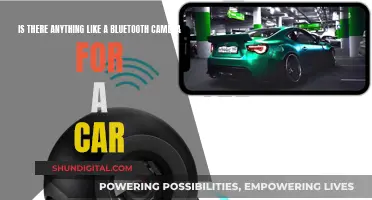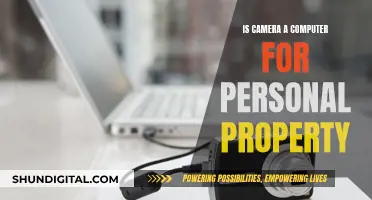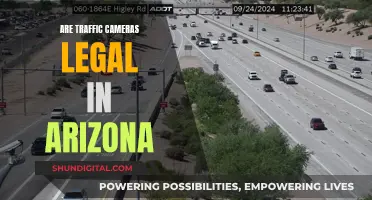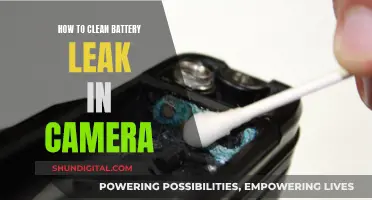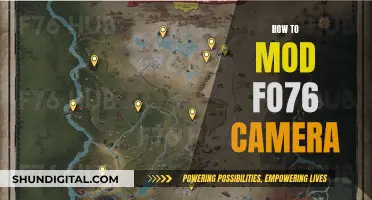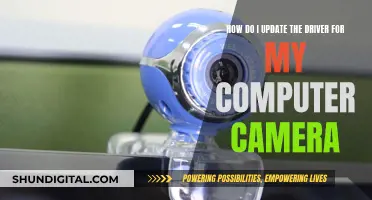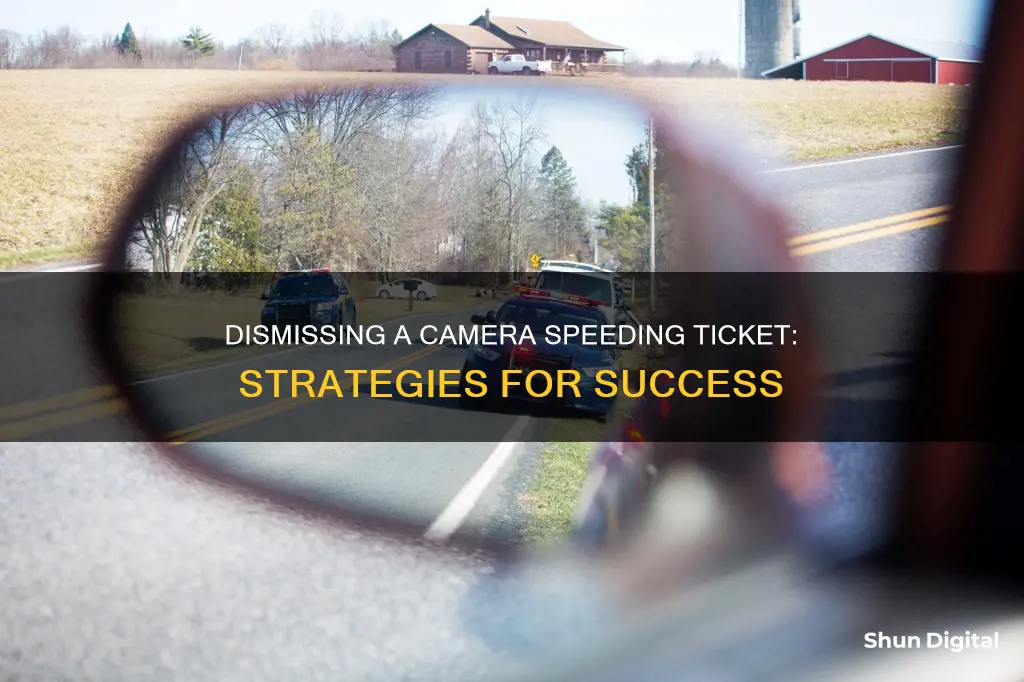
If you've received a speeding ticket from a camera, there are several ways to dismiss it. First, check the date, time, and location of the ticket. If someone else was borrowing your car, you can't be prosecuted. If you were driving, try to remember the details of the incident and write them down. You should also review the photos—if they're blurry, it may be difficult to confirm it's your car. Next, you'll need to plead not guilty by mail, online, or in traffic court. You'll then need to request a formal hearing and research the applicable law, looking for cases in your city or county about traffic cameras. Finally, appear at your hearing, treating the judge and staff with respect, and present your case, using any evidence you've gathered to support your claim.
What You'll Learn

Check the ticket details: date, time, location, and vehicle ownership
When you receive a speeding ticket from a camera, it's important to carefully examine the details on the ticket. Here are some key points to check regarding the date, time, location, and vehicle ownership:
Date and Time:
Check the date and time recorded on the ticket. This information is crucial because it allows you to verify if you were indeed driving the vehicle at that specific time. If someone else was borrowing your car, you may not be liable for the ticket. However, this may vary depending on the laws in your jurisdiction.
Location:
Note the location mentioned on the ticket. This detail helps you reconstruct the scene and recall what happened at that particular location. It is essential to verify that the location matches the area where you were driving.
Vehicle Ownership:
Since camera tickets are typically sent to the owner of the vehicle, confirm that you are the registered owner of the car in question. This information can be found on the ticket and cross-referenced with your records. If there is a discrepancy or if you were not the owner at the time of the infraction, it could be a valid reason for dismissal.
It is important to thoroughly review all the details on the ticket and cross-reference them with your records. This process helps ensure the accuracy of the information and can be the first step in identifying any discrepancies or errors that could lead to a dismissal of the ticket.
Action Camera Batteries: Are They Interchangeable?
You may want to see also

Review photos for clarity and identifiable details
When you receive a speeding ticket in the mail, it should include photos of your car and license plate. Review these photos for clarity and identifiable details. If the license plate isn't clearly visible, it may be difficult for the prosecution to confirm that the car is yours.
If there is no clearly identifiable photo of you in the driver's seat, this may be another defence. While you will be under oath, so you can't argue that you weren't driving if you were, you can argue that the prosecution can't prove you were driving. This defence will only work if you live in a jurisdiction that requires tickets to follow the driver, not the registered owner of the car.
If photos were not included with your citation, you may need to wait until after your trial is scheduled to request copies from law enforcement.
The Evolution of Wyze Cameras: Battery or Plug-In?
You may want to see also

Plead not guilty by mail, online, or in court
If you want to dispute a traffic camera ticket, you must plead not guilty. You can do this by mail, online, or in court.
Pleading Not Guilty by Mail
To plead not guilty by mail, you must fill out the "Plea of Not Guilty" section on your ticket, placing an X through the "Plea of Guilty" section, and then mail the ticket to the court. The court will then process your not guilty plea and mail you a pre-trial conference date. At that time, you will have the opportunity to meet with the Town Attorney to see if a disposition can be reached.
Pleading Not Guilty Online
Some jurisdictions allow you to respond to the citation online, rather than going to a live arraignment in traffic court. You must plead not guilty before the deadline, which is typically within 30 days of receiving the ticket.
Pleading Not Guilty in Court
If you have no option but to appear in traffic court, you should show up at the date and time listed on your citation. This may also be called a first appearance or a notice hearing, depending on your jurisdiction. When you plead not guilty, demand a full formal hearing or trial. You will also be required to attend other hearings, such as a pre-trial hearing or mediation. Attend those as required and aim for a full dismissal of your traffic camera ticket.
Slowing Camera Movement in Blender: Walk Mode Tips
You may want to see also

Research applicable laws and precedents for your defence
The first step in your defence is to examine your ticket. Check the date, time, and location of the ticket. Also, make sure that you were the one driving the car when the ticket was issued. If someone else was driving your car, you cannot be prosecuted.
Next, make a note of the exact code section you're cited for violating and read up on the law. Understand the elements of the violation and the associated penalties. Remember, the prosecution must prove each element of your violation – you are not responsible for proving your innocence.
If you were indeed driving the car, try to remember what you were doing or what was happening at the time, and write down any details you remember. For example, you may have been making a legal right turn on red when the camera took the photo. If you were making a legal manoeuvre, you should be able to get the ticket dismissed.
Now, review the photos. If the notification included photos, confirm that it's your car in the photo and that the photo is clear. If the license plate isn't clearly visible, it may be difficult to confirm that the car is yours. Also, if there's no clearly identifiable photo of you in the driver's seat, the prosecution may have a hard time proving that you were indeed driving.
Applicable Laws and Precedents
- Necessity defence: Some states have a necessity defence for speeding. For example, if you were speeding to avoid a serious accident, or to avoid an obstacle in the road, or if you felt the sudden onset of an illness that required you to pull over.
- No posted speed limit: If there was no posted speed limit or if the sign was obscured, you may argue that you were unaware of the speed limit. However, be aware that there are default speed limits for unmarked roads.
- Radar gun inaccuracy: If the officer's radar gun was inaccurate or interfered with by reflective surfaces, or if it picked up the speed of another vehicle, you may be able to use this as a defence.
- Speedometer calibration: If you believe your speedometer was faulty, you may need to obtain a speedometer calibration to prove this.
- GPS evidence: If you have a GPS that shows you were going slower than the officer claims, this can be used as a defence.
- Misidentification: In some cases, the officer may have incorrectly identified you as the driver, especially in limited circumstances such as a serious accident.
- Hearsay: In some jurisdictions, a red light camera photo is considered hearsay and may be inadmissible in court.
- Confronting witnesses: You have the right to cross-examine witnesses. If no one from the company that maintains the camera shows up to testify, you may be able to object to the use of the photographs.
- Authentication of photographs: If no one from the company that maintains the camera testifies, you may be able to object to the use of the photographs for lack of foundation.
- Lack of evidence: If none of the photos clearly show you driving, or if there is no proof that the traffic light or speed detection system was functioning properly, you may have a defence.
Editing Raw Camera Files: A Step-by-Step Guide
You may want to see also

Present your case in court with supporting evidence
Presenting your case in court with supporting evidence is a crucial step in disputing a camera speeding ticket. Here are some detailed instructions to guide you through this process:
Gather Evidence:
Collect any evidence that supports your case. This can include photographs of the area where the alleged speeding violation occurred, maintenance and calibration records of the speed camera, and statements from passengers or witnesses who can corroborate your version of events. Obtaining these records can help you establish if the camera was functioning correctly and accurately at the time of the incident.
Challenge the Accuracy of the Camera:
Request maintenance and calibration records of the speed camera to assess if it was functioning properly. By obtaining these records, you can determine if the camera was properly calibrated and maintained, which is essential for the validity of the evidence presented against you.
Address Signage Issues:
Argue that the signage indicating the speed limit and the presence of the speed camera was missing, obscured, or incorrectly placed. Take photographs of the current state of the signage to support your claim. This is crucial because proper signage is required for speed camera tickets to be considered valid.
Mistaken Identity:
If you believe the camera captured the wrong vehicle, gather evidence to prove that you were not driving in that area at the time of the violation. This can include providing an alibi or presenting evidence that places you elsewhere, demonstrating that it was impossible for you to be at the location of the speeding incident.
Present Your Case:
When presenting your case in court, ensure that you can convey your evidence and arguments clearly and concisely. Practice your statements beforehand to cover all relevant points effectively. Remember to treat the judge and courthouse staff with respect and refrain from interrupting or speaking directly to the prosecutor during their presentation.
Challenge the Admissibility of Evidence:
During the hearing, you can challenge the admissibility of the photograph as hearsay. In some jurisdictions, a red light camera photo may be considered hearsay, which is an out-of-court statement used to prove the truth of the matter. You can argue that the photo is inadmissible as evidence unless it falls under specific exceptions defined by the court.
Assert Your Rights:
The Sixth Amendment of the Constitution guarantees your right to cross-examine witnesses. Ensure that you have the opportunity to confront and question witnesses who can provide insights into the maintenance and functionality of the speed camera.
Dispute the Authenticity of the Photograph:
If no one from the company that maintains the camera testifies in court, you can object to the use of the photographs due to a lack of foundation. The prosecution must present evidence that the camera, the system connected to the traffic light, and the traffic light itself were functioning properly to rely on the photos as evidence.
Attack the Lack of Evidence:
Even if the photos are clear and admissible, you can argue that the prosecution cannot prove it was you driving the car if there is no clearly identifiable photo of you in the driver's seat. Additionally, the photo does not provide proof that the traffic light or speed detection system was functioning properly. Therefore, the prosecution must establish the reliability and accuracy of the equipment to prove their case.
Abode Streaming Camera: Charging and Power Options
You may want to see also
Frequently asked questions
You should examine your ticket. Check the date, time, and location, and confirm whether you were actually driving the car when the ticket was issued. Generally, the prosecutor must prove that you were driving in that location at that date and time.
Try to reconstruct the scene and write down any details you remember. For example, you may have been making a legal right turn on red when the camera took the photo. If you were making a legal manoeuvre, you should be able to get the ticket dismissed.
If someone else was borrowing your car, you cannot be prosecuted.


